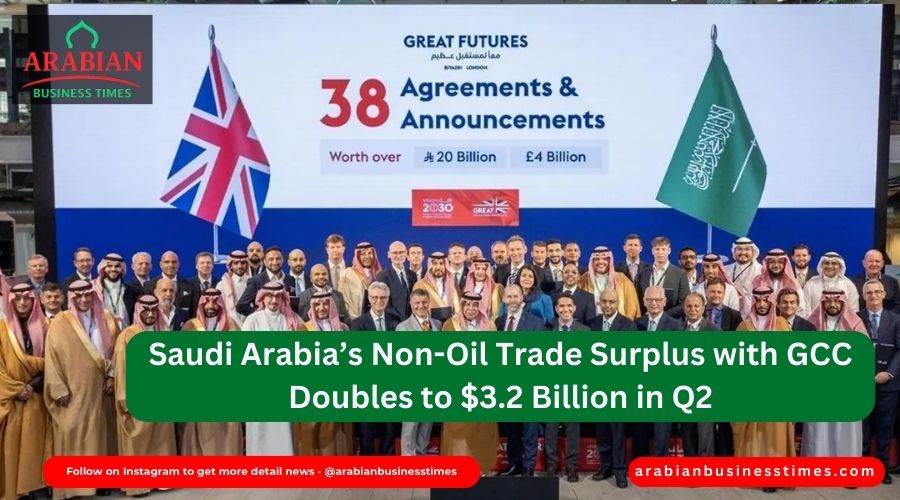Saudi Arabia’s non-oil trade surplus with Gulf Cooperation Council (GCC) countries more than doubled in the second quarter of 2025, reaching $3.2 billion (SR11.9 billion), according to fresh data from the General Authority for Statistics (GASTAT).
The sharp increase reflects the Kingdom’s growing role as a regional trade hub and highlights progress in its efforts to diversify the economy under the ambitious Vision 2030 strategy.
Surplus Driven by Strong Export Growth
Total non-oil trade between Saudi Arabia and its GCC partners hit SR54.3 billion ($14.5 billion) in Q2 2025, a 25.2% increase from SR43.4 billion a year earlier.
-
Non-oil exports (including re-exports): SR33.1 billion, up 35.7% from SR24.4 billion in Q2 2024.
-
Imports from GCC: SR21.2 billion, up 11.7% from SR18.9 billion.
The gap between faster export growth and modest import growth produced the SR11.9 billion surplus, nearly double the SR5.4 billion recorded in Q2 2024.
Re-Exports: The Key Growth Engine
A major driver of the surplus was the surge in re-exports. These climbed 52.4% to SR24.3 billion in Q2 2025, compared to SR15.9 billion a year earlier.
Re-exports refer to goods that Saudi Arabia imports and then exports again without major transformation — a sign of the Kingdom’s strengthening role as a regional distribution hub.
In contrast, national non-oil exports (goods produced inside Saudi Arabia) grew at a slower pace, rising just 4.3% from SR8.5 billion to SR8.9 billion.
Country-Wise Trade Within the GCC
While GASTAT’s report provides aggregate data, trade experts note that the UAE remains Saudi Arabia’s largest GCC trading partner, followed by Kuwait and Qatar.
-
The UAE serves as a key hub for re-exports of electronics, machinery, and high-value goods.
-
Kuwait and Bahrain are important destinations for Saudi building materials, chemicals, and food products.
-
Imports from Oman and Qatar largely include metals, plastics, and energy-related goods.
This pattern underscores the integrated nature of Gulf economies, where cross-border trade is essential for logistics, construction, and retail sectors.
Sectoral Drivers
Though the report did not break down exports by sector, historically Saudi Arabia’s non-oil trade with GCC has been led by:
-
Petrochemicals and plastics – one of the Kingdom’s strongest manufacturing segments.
-
Food and beverages – especially as Saudi companies expand regional market share.
-
Construction materials – cement, steel, and aluminum feed into GCC-wide infrastructure projects.
-
Machinery and vehicles – much of which is re-exported.
The rapid rise in re-exports suggests growing demand for consumer electronics, machinery, and luxury goods being routed through Saudi logistics hubs.
Vision 2030 and Regional Integration
Saudi Arabia’s Vision 2030 aims to diversify the economy away from oil, increase non-oil exports, and position the Kingdom as a logistics and trade hub connecting Asia, Africa, and Europe.
The doubling of the GCC trade surplus in just one year is a tangible sign that these efforts are beginning to yield results. By strengthening re-export channels, upgrading logistics infrastructure, and boosting manufacturing capacity, Saudi Arabia is emerging as a key intermediary in Gulf supply chains.
Experts suggest that if the trend continues, the Kingdom could become one of the top regional players in re-export and distribution trade, reducing reliance on oil revenues and deepening intra-GCC economic integration.
Looking Ahead
Economists forecast that non-oil trade between Saudi Arabia and GCC partners will continue to grow in the second half of 2025, driven by:
-
Increased demand for construction materials linked to mega-projects such as NEOM and UAE Expo developments.
-
Expanding consumer markets in the Gulf.
-
Policy support, including customs facilitation and harmonized GCC trade regulations.
If current growth rates are sustained, Saudi Arabia’s non-oil trade surplus with GCC states could exceed $6 billion for the full year 2025, strengthening its position as the Gulf’s largest economy and a central pillar of regional trade.
Conclusion
Saudi Arabia’s non-oil trade surplus with GCC states more than doubling in Q2 2025 marks a significant milestone in the Kingdom’s diversification journey. While re-exports are the primary engine, steady growth in national non-oil exports shows that Saudi industries are gradually capturing more regional market share.
As the Kingdom accelerates its Vision 2030 agenda, the latest figures highlight a powerful trend: Saudi Arabia is not only exporting goods but also exporting influence across the Gulf economy.

